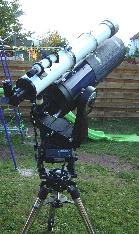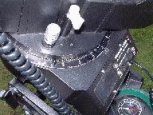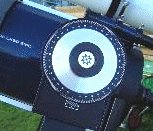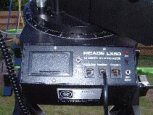Meade LX50
By Simon Stevens
 I had other more basic scopes before I purchased this scope, none of which were very good for astro photography. The odd clear-ish shot of the moon was about all I could manage. My criteria for this scope were to have a good quality scope with a good drive system and very good optics. The go-to stuff was out of my price range, although it would have been very good to have. My budget was only £1000-ish, so I was fairly certain that I would be buying the lower specified LX10. However, when I started to do the actual shopping, I found one suppler with one of the last LX50s. We haggled over the asking price of £1500, and ended up agreeing at £1200, including delivery. So, having passed the necessary visa numbers over, I sat back and waited for the scope to be delivered. When you have time to reflect on a deal like this I find that your head starts to listen to the gremlins! "£1200, that's a bit more than you budgetted for," and "what if the scope’s faulty, or just doesn't work as good as you hoped?". After two days of trying to justify the extra expense and calming myself down, the scope arrived.
I had other more basic scopes before I purchased this scope, none of which were very good for astro photography. The odd clear-ish shot of the moon was about all I could manage. My criteria for this scope were to have a good quality scope with a good drive system and very good optics. The go-to stuff was out of my price range, although it would have been very good to have. My budget was only £1000-ish, so I was fairly certain that I would be buying the lower specified LX10. However, when I started to do the actual shopping, I found one suppler with one of the last LX50s. We haggled over the asking price of £1500, and ended up agreeing at £1200, including delivery. So, having passed the necessary visa numbers over, I sat back and waited for the scope to be delivered. When you have time to reflect on a deal like this I find that your head starts to listen to the gremlins! "£1200, that's a bit more than you budgetted for," and "what if the scope’s faulty, or just doesn't work as good as you hoped?". After two days of trying to justify the extra expense and calming myself down, the scope arrived.
Setting Up
 Three boxes lay on the living room floor. "Well this is it then." I said to myself and set about opening the boxes one by one. The first box contained the scope assembly itself. This was well packed in foam and had survived the trip from London well. I carefully lifted the scope out of the foam and put it on the table. I stood there for a moment and just looked at it. Then carefully I pulled of the dust cover to reveal the pristine piece of glass at the front of the scope. I had never seen a Schmidt-Cassegrain type scope in the flesh before and this one took my breath away. I quickly located the star diagonal and the 25mm eyepiece and slotted them into the scope. The only things that I could see from my living room, in the middle of the day, were the hills. So, having located and released the locks for the declination and the R.A., I swung the scope around for a peek at the hilltops. Even through the double-glazing the view was good and, thanks to the star diagonal, the right way up.
Three boxes lay on the living room floor. "Well this is it then." I said to myself and set about opening the boxes one by one. The first box contained the scope assembly itself. This was well packed in foam and had survived the trip from London well. I carefully lifted the scope out of the foam and put it on the table. I stood there for a moment and just looked at it. Then carefully I pulled of the dust cover to reveal the pristine piece of glass at the front of the scope. I had never seen a Schmidt-Cassegrain type scope in the flesh before and this one took my breath away. I quickly located the star diagonal and the 25mm eyepiece and slotted them into the scope. The only things that I could see from my living room, in the middle of the day, were the hills. So, having located and released the locks for the declination and the R.A., I swung the scope around for a peek at the hilltops. Even through the double-glazing the view was good and, thanks to the star diagonal, the right way up.
The next box contained the tripod legs and head, and the last small box had the wedge assembly in it. These were married together in no time at all, and with the scope secured to the top of the wedge this was a very impressive sight in my living room.
The Mechanics
 The main mirror assembly is 203mm in diameter and is f10, 2000mm focal length. At the front there is a large central obstruction in the shape of the secondary mirror housing. This has three adjusting screws on it so you can collimate the scope, if necessary. The rear cell has the opening for the eyepiece and a large aluminium adjuster knob for focussing. On the top of the scope sits the 6 x 30 finder scope and on the right hand arm top is the declination lock. The manual adjuster for the declination is located on the lower part of the right-hand fork arm.
The main mirror assembly is 203mm in diameter and is f10, 2000mm focal length. At the front there is a large central obstruction in the shape of the secondary mirror housing. This has three adjusting screws on it so you can collimate the scope, if necessary. The rear cell has the opening for the eyepiece and a large aluminium adjuster knob for focussing. On the top of the scope sits the 6 x 30 finder scope and on the right hand arm top is the declination lock. The manual adjuster for the declination is located on the lower part of the right-hand fork arm.
At the top of each fork arm, on the side, there is a large declination scale (6 inches in diameter) which is very easy to read and big enough to be useful. In between the fork arms on the base are the lock and manual adjuster for R.A. A large scale to read the time of R.A. is on the base itself. Also on the base is the control panel and sockets for various items of equipment. The sockets are for auxiliary 12 volt accessories, 12 volt supply (e.g. - from car or power pack), autoguider, hand controller, encoders and the declination power. The autoguider and encoder sockets are no use unless you have the Magellan 2 upgrade kit; at an extra £500 I didn't have enough to purchase this.
Under the right hand fork arm is the declination motor. This has a socket and you have to connect a lead between it and the control panel. This can be a pain as sometimes you will get cord wrap problems. The hand controller is small and cute. It has four buttons on it for north/south (declination) and east/west (R.A.). One other button sets the speed of sidereal rate which ranges from 32x to 2x. Even at 32x the scope doesn't move very fast, but look through the eyepiece and the stars fairly whiz through the field of view.
The tripod is a most substantial affair. 50mm diameter legs which are independently adjustable, and one large bolt to lock the whole thing steady. The wedge is a basic type but still well built. It has a bubble level on it for basic levelling. There is a compass for rough alignment with north and fine adjusters for azimuth. The rear of the wedge has a large adjuster for latitude and there is a scale on the side to roughly set it by. Fine tuning these settings has to be done with the scope pointing at Polaris. If you intend to do astro photography, you are advised in the manual to use the 'drift method'. The R.A. motor is very smooth and quiet in operation but the same can't be said about the declination motor. As the declination motor is not used much when the scope is properly set up this is not much of a nuisance.
In Use
 To use the scope in the field is a fairly straightforward affair. First you set the tripod up and level it off. The wedge is already bolted to the tripod, so all that is left to do is to put the scope on. The scope is not very light so care has to be exercised when moving this around in the dark. Once the bolts have been tightened, all that then remains is to plug in the hand controller and declination motor cables. The base has a battery box in it to run the scope for many hours but I have a power pack that I use and so that has to be plugged in too. Next up is to align the scope which can be a five minute job or a two-hour marathon, as it depends on what you intend to do that evening. In five minutes you can have the scope aligned close enough for viewing and to roughly use the setting scales to find objects.
To use the scope in the field is a fairly straightforward affair. First you set the tripod up and level it off. The wedge is already bolted to the tripod, so all that is left to do is to put the scope on. The scope is not very light so care has to be exercised when moving this around in the dark. Once the bolts have been tightened, all that then remains is to plug in the hand controller and declination motor cables. The base has a battery box in it to run the scope for many hours but I have a power pack that I use and so that has to be plugged in too. Next up is to align the scope which can be a five minute job or a two-hour marathon, as it depends on what you intend to do that evening. In five minutes you can have the scope aligned close enough for viewing and to roughly use the setting scales to find objects.
The full and accurate way of alignment uses the ‘drift method’ and uses up valuable time, but if you want to take long exposures then this is a must. The scope is easy to get used to and you quickly become accustomed to the controls and layout of the scope. In a short time you find yourself whizzing around the sky looking at this and finding that. I have found a lot of objects by using the setting scales but the finder scope still gets used now and then. The finder scope is a little on the small side but you get by with it. When the scope is well lined up the tracking in R.A. is very good indeed. I once tested the tracking by locating a star in the crosshairs of a 12mm illuminated eyepiece and went in for a cup of tea. Some ten to fifteen minutes later when I looked through the eyepiece again the star was just out of position. This could have been easily corrected with the hand controller if I had been taking a picture.
All in All
This is a good sturdy scope which will last for many years. I have never yet had to collimate the optics. I have heard of people having to do this almost every night, so maybe I’m just more careful, or I got a scope with stiffer screws! If you want to do photography with this scope then you have to wait a while and get the set-up bang on. For straight viewing it is quick and stunning in its views. I have added some bits to the scope which make it just a bit easier to use, or to expand on its capabilities. I added a handle to the rear cell, making the scope easier to move in declination. I added the ‘declination fix kit’, which makes the declination motor run more smoothly and is also a better match to the R.A. drive. I purchased an f6.3 reducer corrector which opens up the field of view of all the optics used and also lets me photograph a wider field of view for deep sky objects. I also made brackets to put my Tal 100R on top of the O.T.A. This will allow me to guide the scope during long deep space exposures; well, that’s the theory. I am happy with this scope but there are, as with all things, some little niggles, but nothing too serious to mention. It is all down to personal taste at the end of the day. I’m sure that one day I will buy one of the go-to scopes but, for a long while yet, I will be happy enough with the LX50.
Simon Stevens, December 2001